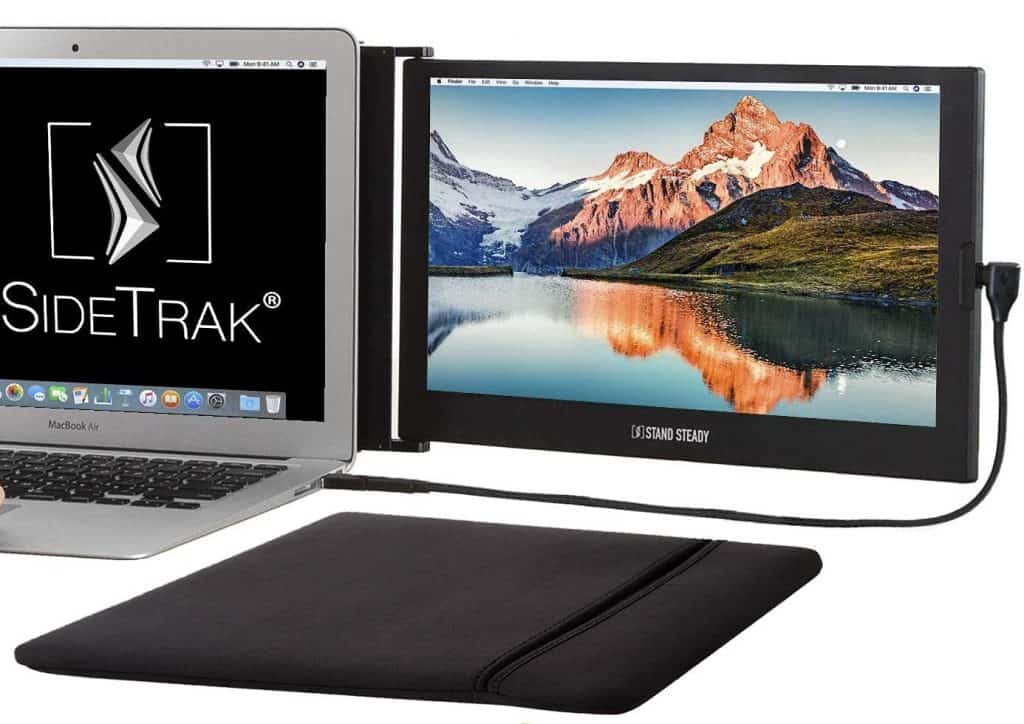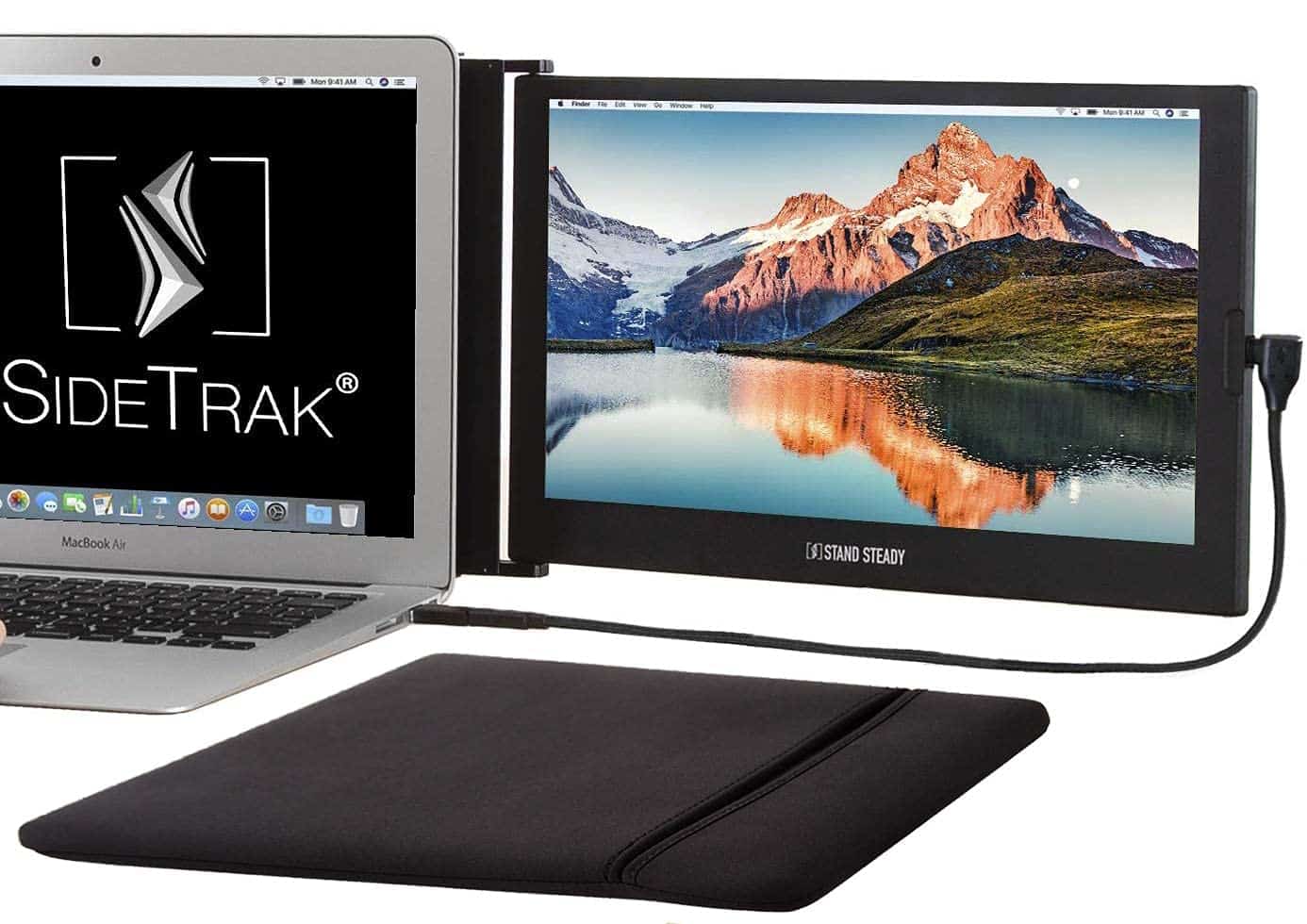Table of Contents
amazon SideTrak reviews
The most unusual portable monitor we’ve come across is the SideTrak, by Stand Steady. This 12.5-inch screen, housed in a frame that magnetically attaches to the back of the laptop, will practically become part of your computer, although it can be removed at will. It’s a smart and compelling approach to bringing a portable second display, but it can’t match the color range or brightness of the Lenovo ThinkVision M14.
It does it with magnets.
The panel backing is housed in a hard plastic box. This shell sits in a metal frame that attaches to the back of your laptop using four magnets that are attached to the frame.
More specifically, the magnets stick to four metal squares, supported with tape, and stick to the back of your laptop during setup. You get two sets of four squares in the box so that you can use SideTrak with two different laptops.
Although the screen is initially hidden behind the laptop from the user’s point of view, when you slide the screen far enough to the right, it will be fully deployed and displayed next to your laptop’s main screen. It can extend far enough to pair with laptops in the 17-inch range, but it’s better suited to panels closer to its size. Note that if you rotate the bezel 180 degrees so that the top magnets are at the bottom, the screen can extend out from the left side of the laptop’s screen, if you like that.
Frame
When placed in its frame, the sidetrack measures 1.7 x 32.5 x 21.6 cm (HWD) and weighs 0.7 kg. When fully extended, the frame and screen together span 71 cm. The screen can be rotated close to or away from the user in this maximum extension position, placing it at a slight angle to the laptop’s screen. However, if you do this, be careful that you can’t bend the connector on the included USB-C cable, which can be done if you rotate the monitor away. Fortunately, monitors with USB-C ports on either end will accept cables, so it’s best to use the opposite port instead of risking damaging the connector or port.
The cable is USB-C on both ends, although you do get a USB-C-to-USB-A adapter included if your laptop lacks a USB-C port. SideTrak supports DisplayPort over USB, which means data, video, and power can be sent over the USB connection simultaneously. Therefore, you can power the display directly from your laptop.
The frame has another trick up its sleeve. Once it’s detached from the laptop and extended, you can rotate the display upwards, creating a makeshift stand for use in portrait mode.
To use SideTrak with your laptop, you also need to download the DisplayLink driver from the DisplayLink site for Mac or Windows. It’s easy enough to install; Instructions are given in the quick start guide.
A few rudimentary points
Although it’s far from perfect, the frame is smart and quite viable support for SideTrak’s display. The screen doesn’t always slide in and out smoothly within the frame; sometimes, it takes a bit of effort to stretch it out. Also, the bottom corner of the SideTrak furthest from the laptop tends to sag slightly when the screen is extended — I noticed this with both laptops I used in testing — but that didn’t affect usability use in any way.
SideTrak uses a 12.5-inch IPS panel. This screen is smaller than the screens of other all-in-one portable monitors we’ve reviewed. But the size should fit when combined with business and general-purpose laptops. SideTrak’s native 1080p resolution (1,920 x 1,080 pixels) is typical of today’s laptop-friendly mobile displays. This resolution is also found in the ThinkVision M14 and EliteDisplay S14, and the Asus ZenScreen Go.
Pairing laptop and monitor: Size problem
According to Stand Steady, SideTrak can be used with most laptops with 13 inches to 17.5 inches screens. (It’s not compatible with the detachable, back-mounted Microsoft Surface Pro 2-in-1 models.) The company also notes that the laptop must be at least 28.6 x 21 cm. If you have a 13-inch laptop, be sure to measure its height before buying a SideTrak.
In testing alongside a 15-inch Apple MacBook Pro, which is slightly shorter than SideTrak’s frame, which means the top two magnets of the chassis extend slightly higher than the frame’s top two metal sheets are glued to the laptop and only partially cover them. The frame feels attached to the laptop firmly enough to hold it, but the look and feel are less than ideal. The minimum clearance between the frame and the bottom of the laptop screen reduced the chances of tilting the screen backward before the bottom of the frame touched the table. Since my XPS 13 is smaller than the recommended size for SideTrak, I’m not using my experience from this paragraph to evaluate the screen, but only as a warning to make sure your laptop is the suitable size.
I performed brightness, color, and contrast tests using a Klein K10-A colorimeter, a Murideo SIX-G signal generator, and Portrait Displays CalMAN 5 software. SideTrak was rated at brightness (brightness per unit area) is 300 nits (candelas per meter squared), which is unusual for a mobile screen. Our leader, the Lenovo ThinkVision M14, shined at 280 nits, while the ZenScreen Touch hit 240 nits, just short of its 250 nitrating. However, in our testing, the SideTrak could only muster 139.3 nits, placing it at the lowest end of the portable monitors we’ve tested in terms of brightness.
Colour
In our color gamut testing, SideTrak covered 69.4 percent of the sRGB color space, a score very similar to both the Asus ZenScreen MB16ACE (69.7 percent) and ZenScreen Touch (69.1 percent), and slightly worse than the Asus ZenScreen Go (72 percent). While that’s a good score compared to most portable monitors we’ve tested recently, it’s far from the best we’ve seen.
The triangles represent colors, including sRGB — essentially, all colors can be created by mixing different percentages of red, green, and blue. The white boxes show the locations of the data points for a full sRGB display. Some of our test points — the black circles — are within the triangle, indicating limited color coverage near the red and purple parts of the spectrum. In contrast, the blue dot in the lower left indicates the range micro coverage is slightly wider towards blue/green.
The general pattern of this chart closely resembles that of most mobile screens we’ve tested over the past year, showing that most of them use the same or similar panels. The one exception, and easily the best portable display in color coverage since we started quantifying it, is Lenovo ThinkVision M14, which covers 97 percent of the sRGB space. (For desktop monitors, we’re looking for at least 95% sRGB coverage.) The AOC I1601FWUX covers only 61.4% of sRGB capacity, and the Lepow 15.6-inch USB-C Portable Monitor covers 65.4%.
However, ZenScreen Go’s 72% sRGB coverage is far from Lenovo’s 97%. That came out in our special photo and video test using the Dell XPS 13 and the MacBook Pro. Red and purple always look a bit duller on a laptop, while other colors are mostly unaffected. That shouldn’t be a problem for most casual business and leisure uses, but video buffs and photo enthusiasts should look elsewhere, starting with the Lenovo ThinkVision M14.
Another consideration: The Stand Steady only offers a one-year warranty on the SideTrak. Most mobile display manufacturers offer a three-year warranty on their screens.
One screen for move
Stand Steady has been manufacturing standing desks, AV carts, and display stands — focusing on ergonomics-friendly products — for nearly a decade, though SideTrak was the first foray into design screen. It’s a smart concept: a portable display that can be attached and integrated with your laptop. It works, although it’s a bit rough around the edges. Screen movement within the frame could be smoother. It has no controls or OSD; Any changes you can make must be done through the menu displayed in your laptop’s operating system (Windows or macOS). Brightness is rather limited, and colors (especially reds and purples) are on the dull side. Its price is a bit high for its screen size and capabilities.
However, you pay the convenience of having a small and secondary display attached to your laptop — you don’t have to remove the SideTrak when traveling with it. If you prefer a separate portable display, the Lenovo ThinkVision M14 is brighter, has a wider color gamut, and has a sturdy stand. Still, the SideTrak Mobile Monitor is an innovative solution that will appeal to business travelers and those who want to add an extra monitor to their laptop setup and don’t mind the thickness.
where can you get a SideTrak online
New SideTrak Swivel Attachable Portable Monitor for Laptop 12.5” FHD IPS Rotating Dual Laptop Screen | Mac, PC, Chrome OS Compatible | All Laptop Sizes | Powered by DisplayPort USB-C or Mini HDMI: Buy it now
SideTrak Solo Portable Monitor 15.8” FHD 1080P LED Anti-Glare IPS Screen| Compatible with Mac, PC, Chrome, PS4, Xbox, & Switch | Powered by USB or HDMI | Built-in DisplayPort, Stand, Speakers, & HDR: Buy it now
sidetrak attachable portable monitor amazon alternatives side trak arcade game swivel australia best buy brightness sidetrack bar black friday booties bike bell by customer service coupon code cable competitors case cord company computer screen chicago coupons discount driver dual vs duex pro reddit keeps disconnecting mac download events for solo freestanding flickering laptop 12 5 gulfstream 2008 gulf stream installation video why rdp wireless my usb how to fix internet that displaylink can be used as a connect review not working magnets macbook turning on reviews promo with protective sleeve drivers return policy records replacement parts 14 slide triple inch software troubleshooting touchscreen twitter twitch trio sidetrak/pages/troubleshooting setup usb-c & usb-a adapter set up uk xebec mobile pixels warranty 15 6 8 4k sierra 840

